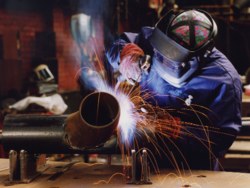Driving the pace of pipework prefabrication offsite

No doubt about the trend towards prefabricated pipework — Terry Reeve.
Large pipe projects are more often prefabricated off site than installed on a site — and smaller projects are catching up with this trend. It’s one of the largest facilities of its kind in Europe — and at the cutting edge of the current boom in off-site pipe fabrication for the UK building-services sector. Pipe Center’s specialist centre at West Horndon in Essex began pioneering the development of off-site pipe fabrication 68 years ago, long before today’s pressures on construction drove pre-fabrication to the top of the industry’s agenda. ‘Many people think of offsite fabrication as something new. However, we have been perfecting the art for three or four generations. With the huge pressures now on contractors to deliver guaranteed quality and delivery times, and the ever-tougher constraints of on-site health and safety, there is no doubt it is an approach whose time has come.’ So says Terry Reeve, the man in charge of the specialist Pipe Center facility, who has over 40 years’ experience in the business. His team of expert engineers and highly skilled fabricators are increasingly in demand as the boom in demand for off-site fabrication boom gathers momentum. He says: ‘The traditional approach, with contractors hot-working onsite, often in cramped conditions and with stringent health and safety requirements to observe, is far from ideal — to say the least. ‘With expectations on finished quality rising all the time and huge penalties for late completion, the industry as a whole has now switched on to the benefits of off-site fabrication — particularly for large projects, where the logistics of materials handling and space requirements are most demanding.’ The result is that around 60% of large pipe-fabrication projects are now carried out offsite. With smaller projects, the proportion is lower — at around 10% — but rising rapidly. In line with the trend, the amount of work passing through the West Horndon facility has increased significantly over the past few years. It has invested heavily in the latest equipment to meet demand. Recent projects include a multi-million pound installation at Canary Wharf, a major new hospital in Derby, and a prestigious new ‘signature’ building destined for the centre of London. The centre is located in the green fields of Essex, just off the M25, with a fast route into the heart of the capital. Its two cavernous workshops have state-of-the-art materials handling and fabrication equipment, giving a highly flexible facility capable of handling the largest and most complicated projects. At the heart of the operation is a team of engineers, pipe-welding and fabrication experts, qualified and coded to the highest industry standards. The average experience among employees at the site is 20 to 25 years. Incoming projects are analysed by skilled engineers in the design office. Detailed drawings are then created for each pipe and joint element, before the workflow is planned into the workshops.

Hot working such as welding is a task that is much better suited to controlled factory conditions than on a construction site.
Once elements are completed, all weld details are logged by the individual responsible, and then X-rayed to ensure integrity. All major projects are subject to full weld mapping — a copy of which is provided to the client upon completion, giving assurance of finished quality. Cost control is one of the key drivers behind the expansion of offsite fabrication. Reflecting this, all work carried out is costed according to an agreed schedule of rates, giving contractors upfront clarity on project costs. Terry Reeve says: ‘It is essential for people to know what work is involved in a project, and how much it will cost. We are strong believers in a clear pricing structure, as it gives complete transparency so that pricing is fair and objective.’ The site handles both carbon steel and stainless pipe, up to any size. The largest project handled recently used 1.8 m diameter pipe, large enough for a man to walk through. The team has developed a particular specialism with the Victaulic jointing system, used where hot working is a problem on site. The team at West Horndon is at the forefront of the technology. It has also pioneered the use of thin-walled stainless-steel pipe, for use in applications where a strong but lightweight solution is required. Stainless steel can be used as a direct replacement for carbon-steel pipe, and does not require costly paint or galvanised finishes. An important benefit of West Horndon is that it shares the location with Pipe Center’s major feeder and stocking facility. This means that all components needed for a project are to hand, and work can begin immediately without delays sourcing products. Terry Reeve says: ‘Traditional ways of working on site are changing rapidly. The pressures today are only going to increase. We are the experts in this area, and when contractors hand over a project to us they know it will be completed on time, to budget — and to the highest specification. ‘I have no doubt that the trend towards offsite fabrication will continue in the future. It plays a critical role in helping contractors deliver the quality now demanded by clients. The expert team at West Horndon are at the forefront is helping them deliver.’

Projects are analysed by skilled engineers in the design office so that detailed drawings can be created for each pipe and joint element.
Related links:
Related articles:











